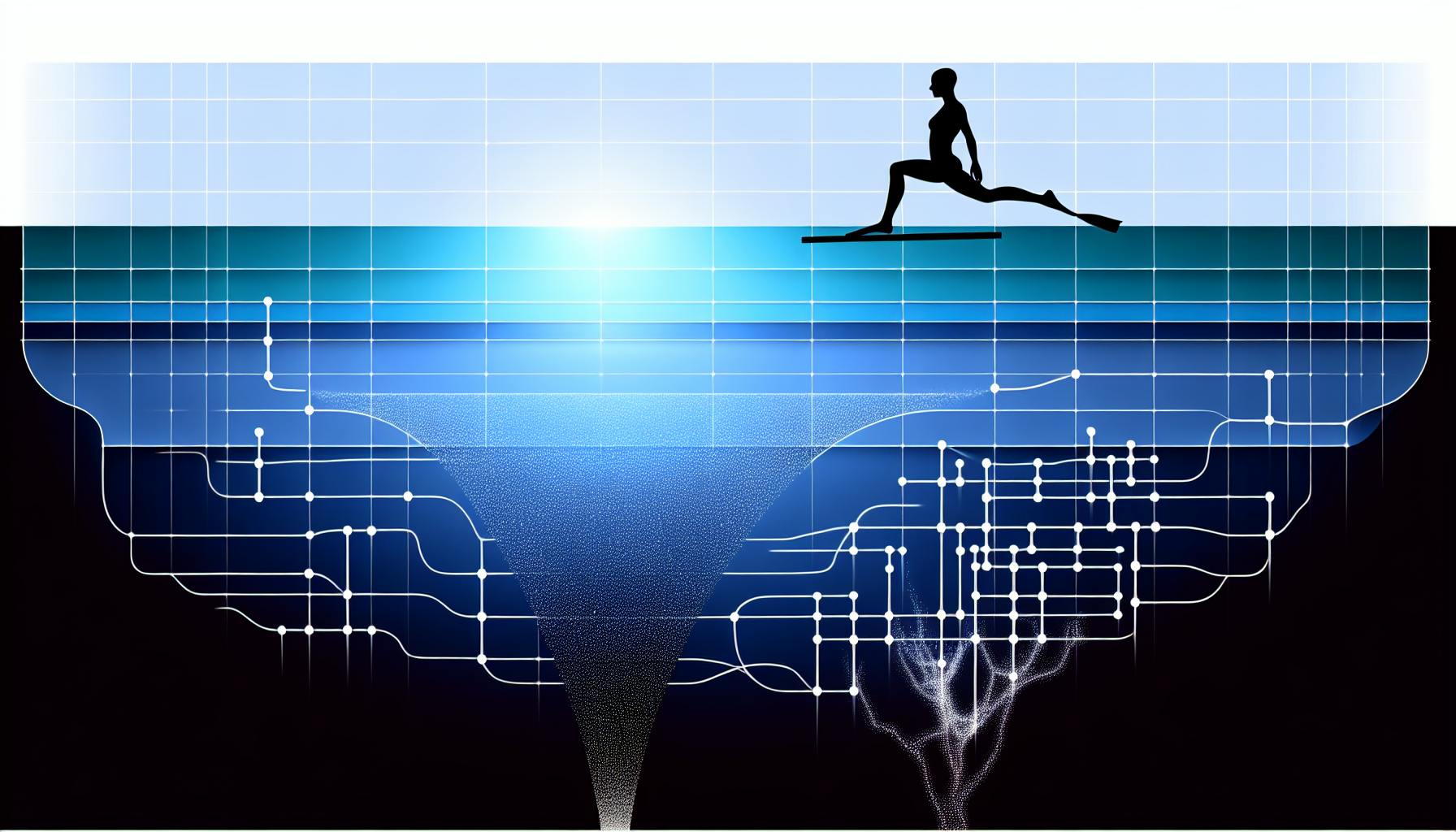Finding meaningful insights in complex data can seem overwhelming for small businesses without extensive data science expertise.
By understanding the core differences between dimensionality reduction and feature selection, business owners can confidently simplify their data for more effective machine learning.
This guide will compare the goals, techniques, and applications of these two approaches to cut through noise and enable impactful modeling, even with limited resources.
Introduction to Simplifying Data in Machine Learning
Dimensionality reduction and feature selection are key techniques in machine learning for simplifying complex datasets. By reducing the number of variables, these methods can improve model performance, shorten training times, enhance interpretability, and reduce overfitting.
Understanding Dimensionality Reduction in Data Science
Dimensionality reduction refers to the process of reducing the number of variables or features in a dataset while retaining as much information as possible. This is done by transforming the data into a lower dimensional space using mathematical techniques like principal component analysis (PCA).
Exploring the Goals of Dimensionality Reduction Techniques
The main goals of dimensionality reduction include:
- Reducing computational costs and storage needs
- Preventing overfitting and improving model generalization
- Enhancing data visualization and understanding
- Identifying hidden patterns and intrinsic data relationships
Defining Feature Selection in Machine Learning
Feature selection involves selecting a subset of the most relevant features from the original dataset. This removes redundant, irrelevant, or noisy features, allowing models to focus on the most predictive variables.
Objectives of Feature Selection
Typical objectives of feature selection include:
- Improving model accuracy by reducing overfitting
- Reducing training time by lowering dataset complexity
- Simplifying models for enhanced interpretability
- Eliminating multicollinearity between features
Dimensionality Reduction vs Feature Selection: Key Differences
The key differences between dimensionality reduction and feature selection include:
- Dimensionality reduction transforms features while feature selection removes them
- Dimensionality reduction techniques are unsupervised while feature selection can be supervised
- Dimensionality reduction may lose interpretability while feature selection maintains explainability
- Feature selection directly eliminates irrelevant features while dimensionality reduction may retain them
In summary, both techniques play important yet distinct roles in simplifying datasets for machine learning.
What is the difference between PCA and feature selection?
Principal Component Analysis (PCA) and feature selection are two popular techniques used in machine learning to reduce the dimensionality of data. However, they work in fundamentally different ways:
PCA
- An unsupervised linear dimensionality reduction technique.
- Transforms the existing features in the data into a new set of features called principal components. These components are ordered by the variance they explain in the data.
- Seeks to project data onto a lower dimensional subspace while preserving as much information as possible. Retains all original features but transforms them.
- Helps identify hidden patterns and the most meaningful basis to re-express complex data.
- Useful when highly correlated features exist and dimensionality needs to be reduced before applying supervised models.
Feature Selection
- A supervised dimensionality reduction technique.
- Selects the most relevant features from the original set of features. Completely excludes non-selected ones.
- Evaluates and ranks each feature based on statistical tests to determine how informative they are for the target variable.
- Useful for eliminating irrelevant and redundant features, making models more interpretable.
- Works well for sparse high dimensional data where most features are noise.
In summary, PCA transforms all features while feature selection filters them. PCA is unsupervised but feature selection uses the target variable. Both techniques simplify data but work in different ways.
What is the main disadvantage of dimensionality reduction?
Dimensionality reduction techniques like PCA come with some potential downsides, although their advantages typically outweigh these cons:
Loss of Information
When reducing the number of features in a dataset, some information may inevitably be lost or discarded. This occurs because the dimensionality reduction process prioritizes preserving the most useful information and relationships in fewer dimensions.
For example, PCA transforms the data into fewer principal components that explain a maximum amount of variance. However, less influential variables may get ignored, resulting in a loss of granular insights.
The key is to strike the right balance - reduce dimensions enough to simplify and streamline the data, but not so drastically that key insights are compromised.
Data Distortions
In some cases, dimensionality reduction can distort inter-variable relationships and data distributions in the original high-dimensional space.
Techniques like PCA focus on preserving pairwise linear relationships between variables when projecting data into lower dimensions. However, more complex nonlinear relationships may get obscured.
Additionally, anomalies and outliers could get masked through the dimensionality reduction process. Their unusual position relative to standard data points could get lost.
Practitioners need to experiment with multiple reduction techniques and dimensionality targets to assess these data integrity risks.
Overall the disadvantages boil down to potential information loss and data distortions. But when leveraged judiciously, dimensionality reduction enables building simpler, more efficient, and better-performing models. The key is applying it strategically for each use case.
How dimensionality reduction is different from data reduction?
Dimensionality reduction and data reduction are two techniques used to simplify datasets in data analysis and machine learning. However, they operate differently:
-
Dimensionality reduction focuses on reducing the number of variables or features in a dataset. It identifies and removes redundant, irrelevant, or highly correlated features to create a more compact set of features that preserve most of the original information. Common dimensionality reduction techniques include Principal Component Analysis (PCA), Linear Discriminant Analysis (LDA), and t-SNE.
-
On the other hand, data reduction aims to decrease the total volume or size of the dataset. It may use sampling or aggregation methods to reduce the number of data points while attempting to maintain the statistical properties and integrity of the full dataset. Example data reduction methods include random sampling, stratified sampling, clustering, histograms, etc.
In summary, dimensionality reduction focuses on reducing the number of variables in a dataset, while data reduction is about reducing the volume of the dataset itself. Both techniques are valuable in managing and analyzing large datasets for machine learning and data analysis tasks. Dimensionality reduction removes redundant features, while data reduction removes data points. When used together wisely, they can simplify datasets for more effective modeling without losing meaningful information.
What is the difference between PCA and RFE?
The most important difference between Principal Component Analysis (PCA) and Recursive Feature Elimination (RFE) for dimensionality reduction is:
-
PCA transforms the existing features into a new, lower-dimensional space, while preserving as much information as possible. The original features are combined and transformed into a new set of features called principal components.
-
RFE, on the other hand, simply selects a subset of the original features without transforming them. It removes features recursively based on their importance for predicting the target variable.
In summary, PCA changes the features while RFE just selects a subset of features. While RFE selects features that are useful for a specific prediction task, PCA transforms features more generally to uncover latent characteristics.
So in essence, RFE performs feature selection to pick the best features for a model, while PCA performs feature extraction to uncover fundamental patterns and create entirely new features representing the data.
sbb-itb-ceaa4ed
Delving into Dimensionality Reduction Techniques
Dimensionality reduction techniques aim to simplify complex high-dimensional data while preserving as much information as possible. These techniques transform data into lower dimensions, reducing complexity and enabling more efficient modeling.
Principal Component Analysis (PCA): A Linear Approach
PCA is a popular linear dimensionality reduction method. It rotates data onto a new coordinate system such that the greatest data variance aligns with the first coordinate (principal component), second greatest variance on the second coordinate, and so on. By preserving variables capturing the most information, PCA reduces data to fewer dimensions without much information loss.
Linear Discriminant Analysis (LDA) for Classification
LDA aims to find the linear combination of features that maximizes separation between multiple classes. It is commonly used for classification and dimensionality reduction. LDA can provide improved model accuracy and faster training times by reducing dimensions while preserving class-separating information.
Nonlinear Dimensionality Reduction Techniques
Beyond linear methods, techniques like t-SNE, UMAP, and autoencoders use nonlinear transformations, allowing more flexibility to uncover complex data structure. These can map data into 2D or 3D for improved visualization as well.
Information Preserving in Dimensionality Reduction
The goal of dimensionality reduction is to simplify data while retaining as much useful information as possible for downstream tasks. Assessing preservation of variance, clustering patterns, and predictive accuracy guides technique selection and dimensional configuration. Overall, reducing dimensionality can improve computational efficiency without sacrificing model performance.
Understanding Feature Selection Strategies
Feature selection is an important step in machine learning pipelines to identify the most relevant input features for building highly accurate predictive models. By removing redundant, irrelevant, and noisy features, feature selection leads to improved model performance, faster training times, and enhanced model interpretability.
Filter Methods for Unsupervised Feature Selection
Filter methods evaluate features based on their statistical properties, without using any machine learning algorithm. Common statistical metrics used by filter methods include:
- Variance - Selects features with highest variance across samples
- Correlation - Removes highly correlated features
- Mutual Information - Selects features that have the highest mutual information with the target
Filter methods are fast, scalable, and model-agnostic. However, they ignore feature dependencies and interaction effects. Example filter methods include ANOVA, Chi-Square, Pearson Correlation, and Mutual Information.
Wrapper Methods and Their Predictive Power
Wrapper methods select feature subsets to optimize the performance of a specific machine learning model. The model is trained on different combinations of features and evaluated on a holdout set. Features from the best performing subset are selected.
Wrapper methods capture feature interactions and dependencies, leading to subsets with higher predictive power. However, they have higher computational expense and risk of overfitting compared to filter methods. Examples include recursive feature elimination and genetic algorithms.
Embedded Methods: Integrating Feature Selection with Learning
Embedded methods perform feature selection as part of the model construction process, evaluating feature importance specific to the objective function of the model. Examples include L1 and L2 regularization methods used in linear regression and neural networks.
The main advantage of embedded methods is that they include feature selection as part of the model itself, avoiding separate pipelines. This leads to models better tuned for prediction and faster performance.
Feature Extraction vs Feature Selection
While feature selection reduces the number of features used, feature extraction creates new features by transforming the original feature space. Techniques like PCA use linear combinations of features to capture the maximum variance and project data onto a lower dimensional subspace.
So while feature selection eliminates redundant or irrelevant features, feature extraction combines existing features to uncover latent information and patterns in data for more effective modeling.
Choosing Between Dimensionality Reduction and Feature Selection
Dimensionality reduction and feature selection are two techniques in machine learning that help simplify datasets by reducing the number of features. Choosing between them depends on several factors:
Assessing Data Size and Computational Resources
The size of your dataset and available computational resources impact the choice between dimensionality reduction and feature selection.
Dimensionality reduction techniques like PCA can be computationally intensive for very large datasets. In contrast, feature selection is less resource heavy. With limited compute resources, feature selection may be preferable.
However, dimensionality reduction can summarize key information even for massive datasets. With sufficient resources, it can model the most salient relationships within big data.
Impact on Model Accuracy and Complexity
In general, dimensionality reduction provides higher model accuracy as it preserves more information about feature relationships. However, it increases model complexity.
Feature selection directly reduces features, decreasing model complexity. But it may marginally reduce accuracy by removing interacting variables.
So if optimizing prediction accuracy is critical, dimensionality reduction has an advantage. But feature selection simplifies modeling.
The Importance of Understanding Data Characteristics
You need to understand intrinsic data properties to choose between the two techniques.
Dimensionality reduction excels at handling correlated features and revealing latent variables. Feature selection targets independent, directly informative variables.
Analyze correlations, feature importance scores, etc. to determine the nature of your data before selecting a technique.
Aligning Techniques with the Goal of Analysis
Finally, match the technique to the end goal. Dimensionality reduction is great for visualizing high-dimensional data, information retrieval, and predictive modeling. Feature selection aids model interpretation and causal analysis.
Consider whether you want to understand, predict, or retrieve. Then choose reduction or selection accordingly.
In summary, consider data size, resources, accuracy needs, relationships, and goals when deciding between dimensionality reduction and feature selection for simplifying data.
Real-World Applications and Case Studies
Business Scenario and Data Complexity
Many small businesses collect large amounts of customer data from various sources like websites, mobile apps, and customer relationship management (CRM) systems. This data can include customer demographics, purchase history, website interactions, survey responses, and more.
While rich in potential insights, the high dimensionality and complexity of this data makes it difficult to analyze and extract meaningful patterns. Small businesses with limited analytics resources can struggle to make sense of the data overload.
Applying Dimensionality Reduction vs Feature Selection Example
To simplify the customer data and enable better analysis, the business could apply dimensionality reduction techniques like principal component analysis (PCA).
PCA would identify and retain only the most important dimensions in the data that explain majority of the variance. Dropping redundant and irrelevant dimensions makes the data less noisy and more manageable for analysis using Excel or basic data science techniques.
Alternatively, unsupervised feature selection algorithms could be used to automatically select subsets of features that are most informative. This allows focusing modeling efforts on key inputs while ignoring less useful ones.
Interpreting Results for Business Insights
Post-analysis, the reduced set of dimensions or features can be examined to understand the main drivers and relationships in customer behaviors.
For example, purchase history data may show that order frequency and average order value are highly correlated. This insight can inform marketing campaigns aimed at increasing customer lifetime value.
Evaluating the Business Impact of Simplified Data
By removing noisy and redundant dimensions from complex business data, small companies can save analytical costs and extract insights more efficiently using existing tools and resources.
Ops teams are relieved of data wrangling overhead and can spend more time interpreting results and identifying actions to reach business goals. Marketing is able to segment better and sales can focus efforts on high-value targets.
Overall data simplification delivers tangible benefits in analytics velocity, productivity, and ROI.
Conclusion: Simplifying Data for Effective Machine Learning
Recapitulating the Main Differences
Dimensionality reduction techniques like PCA transform the existing features in a dataset to create new features that convey similar information. This reduces the dimensionality of the dataset while preserving key information.
On the other hand, feature selection techniques select a subset of the original features in a dataset based on their relevance. This also reduces dimensionality but without transforming features.
Guidance on Selecting the Right Data Simplification Approach
Use dimensionality reduction when you need to reduce a high-dimensional dataset to 2D or 3D for visualization purposes or before feeding the data into a machine learning model. It is also useful for compressing data while retaining the maximum information.
Apply feature selection when you want to eliminate irrelevant or redundant features from a dataset. This works well for removing noise from data and improving model performance by focusing on the most predictive features.
Empowering Small Businesses with Simplified Data
Simplifying high-dimensional data using techniques like PCA or feature selection allows small businesses to leverage machine learning even with limited data science resources. Reduced datasets are faster to analyze and simplify the process of training accurate models. This enables small companies to tap into data-driven insights for critical business objectives.


